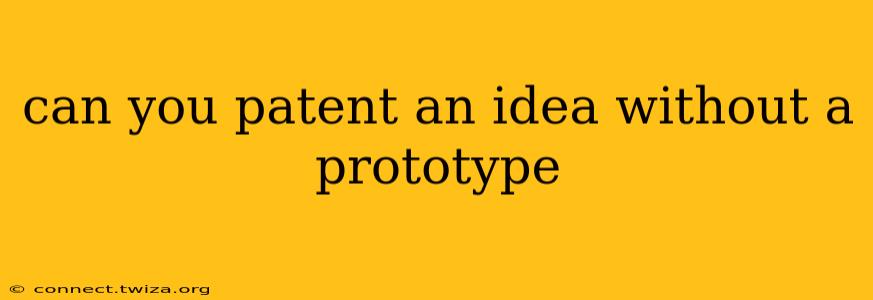Can You Patent an Idea Without a Prototype?
The short answer is: generally, no. While you can't patent a mere idea, you can patent an invention, and the level of development required varies depending on the type of patent and the jurisdiction. Let's delve deeper into the complexities of patenting an invention before a fully realized prototype exists.
What is Patentable?
To be patentable, an invention must meet several criteria, including being novel (new and not obvious to someone skilled in the art), useful, and non-obvious. Simply having a "good idea" isn't enough. The idea needs to be concretely defined and described in sufficient detail to enable someone skilled in the relevant field to reproduce the invention. This is where the "prototype" question becomes crucial.
The Role of a Prototype (or its Alternatives)
A prototype isn't always a physical model. It can take many forms:
- Working Prototype: This is the ideal scenario—a fully functional model demonstrating the invention's capabilities. It greatly strengthens a patent application.
- Functional Prototype: This shows the key functions of the invention, even if it's not fully refined or aesthetically pleasing.
- Proof-of-Concept Prototype: This demonstrates the feasibility of the invention, often through simulations, computer models, or limited physical demonstrations.
- Detailed Drawings and Specifications: Comprehensive technical drawings, schematics, and written descriptions can, in some cases, substitute for a physical prototype, especially for complex inventions. These must be incredibly detailed and precise.
The level of development needed depends heavily on the complexity of the invention and the technology involved. A simple mechanical device might require a more complete prototype than a software algorithm, which might be adequately represented by source code and a detailed description of its function.
Provisional Patent Applications: A Bridge to a Prototype
A provisional patent application (in the US) allows you to establish an early filing date for your invention without the need for a fully developed prototype. It's a less expensive and less demanding process than a non-provisional application. However, a provisional application is only temporary—it buys you time to develop your invention further. You must file a non-provisional application within one year of the provisional filing date, and this non-provisional application will require a much more detailed description of the invention, often including a prototype or substantial evidence of its functionality.
What About Software Patents?
Software patents are often granted based on detailed descriptions of algorithms and code, rather than physical prototypes. However, even here, demonstrating the functionality and the novelty of the software is critical. You'll still need to explain precisely how your software works and why it's a significant advance over existing technology.
H2: What are the steps to take to patent my idea?
The steps to obtain a patent vary significantly by country. However, generally, the process involves:
- Research: Thoroughly research existing patents to ensure your invention is novel and non-obvious.
- Drafting: Prepare a detailed patent application, including drawings, specifications, and claims. This is often best done with the help of a patent attorney.
- Filing: File the application with the appropriate patent office.
- Examination: The patent office will review your application, potentially requesting further information or clarification.
- Granting: If the patent office approves your application, your patent will be granted.
H2: How much does it cost to patent an idea?
The cost of patenting an idea can vary significantly, depending on the complexity of the invention, the number of claims, and the need for legal assistance. It is important to understand there are costs associated with filing fees, attorney fees, and prototype development.
H2: How long does it take to patent an idea?
The time it takes to get a patent granted varies depending on the patent office and the complexity of the invention. It can range from a few months to several years. A provisional application can accelerate the overall process by giving you a head start.
In conclusion, while you can't patent a vague idea, you can protect your invention even before a fully realized prototype exists. However, a detailed description and, in most cases, some form of prototype or proof of concept are crucial to successfully securing a patent. Consulting with a patent attorney is highly recommended to navigate this complex process.
